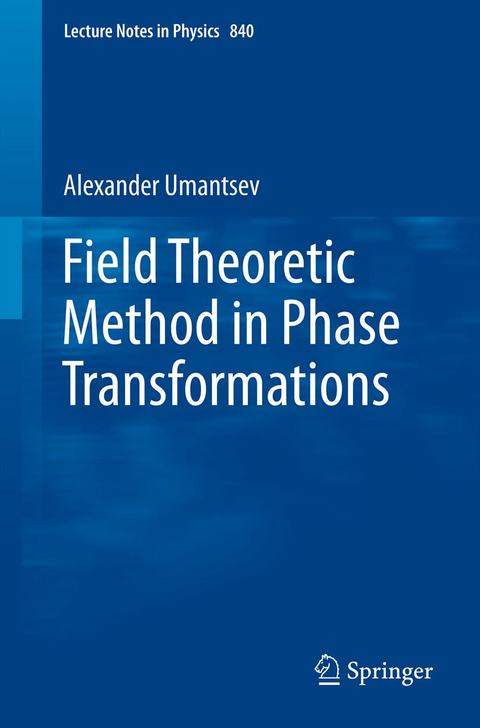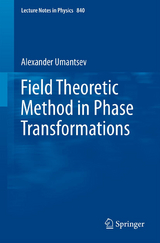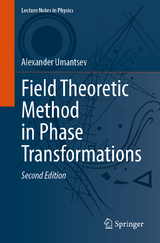Field Theoretic Method in Phase Transformations
Springer-Verlag New York Inc.
978-1-4614-1486-5 (ISBN)
The main subject of the book is the continuum, field theoretic method of study of phase transformations in material systems. The method, also known as "phase field", allows one to analyze different stages of transformations on the unified platform. It has received significant attention in the materials science community recently due to many successes in solving or illuminating important problems. The book will address fundamentals of the method starting from the classical theories of phase transitions, the most important theoretical and computational results, and some of the most advanced recent applications.
1: Introduction.- What Is This Book About?.- Who Is This Book For?.- Historical Note.- Nomenclature.- Acknowledgements.- 2: Landau Theory of Phase Transitions.- 2.1 A Phase and Phase Transition.- 2.2 Phase Transition as Symmetry Change: the Order Parameter.- 2.3 Phase Transition as a Catastrophe: the Free Energy.- 2.4 Ehrenfest Classification.- 2.5 The Tangential Potential.- 2.6 Phase Diagrams and Measurable Quantities.- 2.6.1 First-Order Transitions.- 2.6.2 Second-Order Transitions.- 2.7 Effect of External Field on Phase Transition.- 3: Heterogeneous Equilibrium Systems.- 3.1 Theory of Capillarity.- 3.2 The Free Energy.- 3.3 Equilibrium States.- 3.4 One-Dimensional Solutions of Equilibrium Equation.- 3.4.1 Classification.- 3.4.2 Type-e1 States: Bifurcation off the Transition State.- 3.4.3 Type-e3 States: Approach to Thermodynamic Limit.- 3.4.4 Type-e4 State: Plane Interface.- 3.4.5 Interfacial Properties: Gibbs Adsorption Equation.- 3.4.6 Type-n4 State: Critical Plate—Instanton.- 3.5 Free Energy Landscape.- 3.6 Multidimensional Equilibrium States.- 3.6.1 Quasi One-Dimensional States: Drumhead (Sharp Interface) Approximation.- 3.6.2 Critical Droplet—3d Spherically-Symmetric Instanton.- 3.6.3 Small Deviations From Homogeneous Equilibrium States: Fourier Method.- 3.7 Thermodynamic Stability of States: Local versus Global.- 3.7.1 Type-e4 State: Plane Interface.- 3.7.2 General Type-e and Type-n States.- 3.7.3 3d Spherically-Symmetric Instanton.- 3.8 Gradients of Conjugate Fields.- 4: Dynamics of Homogeneous Systems.- 4.1 Evolution Equation: The Linear Ansatz.- 4.2 Solutions of the Linear-Ansatz Dynamic Equation.- 4.2.1 Evolution of Small Disturbances.- 4.2.2 More complicated types of OPs.- 4.2.3 Critical Slowing Down.- 4.2.4 Non-Linear Evolution.- 4.3 Beyond the Linear Ansatz.- 4.4 Relaxation with Memory.- 4.5 Other Forces.- 5: Evolution of Heterogeneous Systems.- 5.1 Time-Dependent Ginzburg-Landau Evolution Equation.- 5.2 Motion of Plane Interfaces.- 5.3 Dynamic Stability of Equilibrium States .- 5.3.1 Homogeneous Equilibrium States.- 5.3.2 Heterogeneous Equilibrium States.- 5.3.3 Morphological Stability of Moving Plane Interface.- 5.4 Motion of Curved Interfaces: Drumhead (Sharp Interface) Approximation.- 5.4.1 Non-Equilibrium Interface Energy.- 5.4.2 Evolution of a Spherical Droplet.- 5.5 Dynamics of Domain Growth.- 6: Thermo-Mechanical Analogy.- 7: Thermodynamic Fluctuations.- 7.1 Classical Nucleation Theory.- 7.2 Free Energy of Equilibrium System with Fluctuations.- 7.3 Levanyuk-Ginsburg Criterion.- 7.4 Dynamics of Fluctuating Systems: Langevin Force.- Evolution of the Structure Factor.- Drumhead Approximation of the Evolution Equation.- Evolution of the Interfacial Structure Factor.- Nucleation in the Drumhead Approximation.- 8: More Complicated Systems.- 8.1 Conservative Order Parameter: Theory of Spinodal Decomposition.- 8.1.1 Thermodynamic Equilibrium in Binary Systems.- 8.1.2 Equilibrium in Inhomogeneous Systems.- 8.1.3 Dynamics of Decomposition in Binary Systems.- 8.1.4 Evolution of Small Disturbances.- 8.1.5 Role of fluctuations.- 8.2 Complex Order Parameter: Ginzburg-Landau’s Theory of Superconductivity.- Order Parameter and Free Energy.- Equilibrium Equations.- 8.2.3 Surface Tension of the Superconducting/Normal Phase Interface.- Multicomponent Order Parameter: Crystallographic Phase Transitions.- Invariance to Symmetry Group.- Inhomogeneous Variations.- 8.3.3 Equilibrium States.- 8.4 Memory Effects: Non-Markovian Systems.- 8.5 “Mechanical” Order Parameter.- 9: Thermal Effects: Coupling to “Hydrodynamic” Variables.- 9.1 Equilibrium States of a Closed (Adiabatic) System.- 9.1.1 Type-E1 States.- Type-E2 States.- Generalized Heat Equation.- Emergence of a New Phase.- Motion of Interfaces: Drumhead Approximation.- 9.4.1 Generalized Stefan Heat-Balance Equation.- 9.4.2 Generalized Kinetic Equation.- 9.4.3 Gibbs-Duhem Force.- 9.4.4 Inter-Phase Boundary Motion: Heat Trapping.- 9.4.5 APB Motion: Thermal Drag.- Length and Energy Scales.- Pattern Formation.- 1-Dimensional Transformation.- 2-Dimensional Transformation.- 10: Transformations in Real Materials.- 10.1 Parameters of FTM.- 10.2 Boundaries of Applicability of FTM.- 11: Extensions of the Method.- 11.1 Cellular Automata Method: “Poor Man’s Phase Field”.- 11.2 Continuum Models of Grain Growth.- Multiphase Field Models.- Orientational Order Parameter Field Models.- Phase-Field Crystal.- 11.3 Epilog: Successes Stories.- Appendix A: Coarse-Graining Procedure.- Appendix B: Calculus of Variations and Functional Derivative.- Appendix C: Orthogonal Curvilinear Coordinates.- Appendix D: Lagrangian Field Theory.- Appendix E: Eigenfunctions and Eigenvalues of The Schrödinger Equation and Sturm’s Comparison Theorem.- Appendix F: Fourier and Legendre Transforms.- Appendix G: Stochastic Processes.- The Master and Fokker-Plank Equations.- Decomposition of Unstable States.- Diffusion in Bistable Potential.- Autocorrelation Function.- The Langevin Approach.- Appendix H: Two-phase equilibrium in a closed binary system.- Appendix I: The Stefan Problem.- Appendix K: “On the Theory of Adsorption of Sound in Liquids” By L. I. Mandelshtam and M. A. Leontovich.- Index.
| Reihe/Serie | Lecture Notes in Physics ; 840 |
|---|---|
| Zusatzinfo | 1 Tables, black and white; 27 Illustrations, color; 28 Illustrations, black and white; X, 344 p. 55 illus., 27 illus. in color. |
| Verlagsort | New York, NY |
| Sprache | englisch |
| Maße | 155 x 235 mm |
| Gewicht | 545 g |
| Themenwelt | Naturwissenschaften ► Physik / Astronomie ► Atom- / Kern- / Molekularphysik |
| Naturwissenschaften ► Physik / Astronomie ► Festkörperphysik | |
| Naturwissenschaften ► Physik / Astronomie ► Thermodynamik | |
| Technik ► Maschinenbau | |
| Schlagworte | Field Theoretic Method • interfaces • multiscale modeling • Non-Equilibrium Systems • phase transitions |
| ISBN-10 | 1-4614-1486-5 / 1461414865 |
| ISBN-13 | 978-1-4614-1486-5 / 9781461414865 |
| Zustand | Neuware |
| Informationen gemäß Produktsicherheitsverordnung (GPSR) | |
| Haben Sie eine Frage zum Produkt? |
aus dem Bereich





